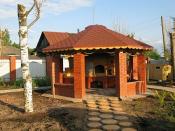Search
Login to the system
How to properly lay a pavement on the household plot, useful tips
The arrangement of the territory of the country area provides for the construction of the tracks. Difficulties usually arise when choosing a material, because each homeowner wants them to serve for a long time, walking on them was safe, to the same paths should have an attractive look and decorate landscape design.
Content
- Advantages of paving blocks
- How to store acquired paving
- Materials and tools that need to work
- How to prepare a platform for laying tile
- How to lay paving slaves - prepare the foundation of the track
- How to put a paving slave - observe the slope video
- How to lay a paving system by level video
- Strengthening borders and frustration video
Advantages of paving blocks

In most cases, during the construction of tracks, the tiles are used, the most attractive option of which can be considered paving slam. Among her advantages:
- long service life
- environmental purity,
- the possibility of partial repair by replacing individual fragments,
- the manifold of shades, textures and forms of paving slaves, which allows you to implement original design ideas.
In terms of reliability and strength, it is much superior to such a common road cover as asphalt.
The trading network today offers several types of blocks:
- kololaya having dimensions 50x50x50, 70x50x50, 100x100x100, its cost can fluctuate depending on the size and shade,
- koloto-sawn, more expensive, the upper and lower surface is processed in a thermal method, and the side have a slot surface,
- full-sawn, having a surface undergoing thermal processing,
- laming granite, which is most applied to the construction of country paths, its dimensions: 10x10x5 cm, less frequently there are tiles in size 5x5x5 cm, 20x20x5 cm, 7x7x7 cm.

When buying a granite blocking, you should pay attention to the class of radioactivity specified in the documents - on the territory of private possessions where people live are recommended to use the first class material if the pavement has a second class of radiological safety, it is suitable for the construction of industrial or economic objects, if the material It has a third class of radioactivity, it is impossible to use it in residential sites.

A special place in this series occupies a clinker paving, characterized by excellent anti-slip qualities, easy cleaning, the possibility of exploitation throughout at least a century. It does not absorb oils and gasoline, to repair the track will need only to replace individual fragments or simply flip over the other side of those that have already been in operation. High demand for clinker paving provides its attractive look, wide color scheme.
When buying a tile, you should slightly increase the calculated quantity - when the material is trimmed, part of it will go into waste.
How to store acquired paving

In order for the material to not lose its decorative qualities even before laying, the following recommendations should be followed. Store a pavement should be kept on pallets located on a platform from asphalt or reinforced concrete, which does not see the heavy load, for example - during the rain. If you have to install pallets to Earth, it is not recommended to lay more than 10 rows of tiles, in addition, the pallets with the material are desirable to hide from the rain with a moisture-proof film.
Materials and tools that need to work

To perform work it will be necessary:
- building level of meter length,
- 2 and 6 cm of a metal profile cross section 20x40 mm,
- wooden pegs and metal pins,
- kapron cord,
- rubber hammer-kiyanka
- rubber hammer for laying paving slaves,
- trowel,
- roulets Long 2nd 10 m,
- heavy metal corner and clamp with which it can be fixed tiles in front of cutting,
- the broom for cleansing seams between laid tiles.
It will be necessary to get a breakdown with a grinder and a steel disk with a diameter of 230 mm for cutting concrete and stone.
How to prepare a platform for laying tile

High-quality training platform for laying paversing - the stage of work requiring special attention. First, the platform is marked, then a multilayer pillow is prepared. In the place of the removed the upper layer of the soil laid a layer of geotextile fiber. Next, fall asleep 15 cm layer of gravel. Over gravel - 10 -15 cm of sand. Make a cement-sand tie a thickness of at least 2 cm.
Before laying a paving, with your own hands, you should install fragments of the border. Cleaning is customary to install on a sandy cement solution, but practical experience shows that it is better to first install it on a dry sandy cement mixture. In case of need, a curb stone can be shifted and to fit it close to the last row of the paving. Before installing curbstones, it will not be superfluous to make sure that they are smooth - you can often find defective products. If the irregularities on the generation are detected, then such a fragment is better to use on sites not very noticeable. You can also cut a stone if the pieces are needed.
How to lay paving slaves - prepare the foundation of the track

Stacking pavers can be produced on sand or on a sandy cement mixture. Although it is often possible to observe that the pavements on the squares and sidewalks in the city fit into pure sand, when building tracks with their own hands, it is still better to use a mixture of cement and sand for laying - the use of such a mixture will prevent the shelling of sand from under the tiles.
The recipes of cooking a mixture can be found a lot, the proportions of the components in them can be different, from 1: 1 to 1: 8, it should actually be repelled on how the mixture will prepare - if using a concrete mixer that allows you to get the perfect mixing of the components, then you can take On 7 parts of the sand 1 part of the cement, if you do work with the help of a shovel, then it is best to apply the classic option and on 4 parts of the sand take 1 part of the cement.
Sand used for laying can be both dry and wet, still the mixture will not have time to capture the mixture if errors will be detected.
Mixing components is more convenient to use everything close to the place of styling, you can use a metal sheet for this, you can mix right on Earth.
How to put a paving slave - observe the slope

So that on the paved track or the playground, it is necessary to comply with the bias, it ranges from 5 to 15 mm per 1 m. It is possible to slightly increase the slope, but in no case can it be done with less than 5 mm per 1 m. Ideal stacking blocks - The point is not simple, therefore, if the slope is not compared, there will be puddles in each small excavation on the tracks.
How to lay a paving system by level

In order for the track surface to look neatly need when laying the tile to apply the level. Its use will allow you to get a flat surface, the tiles are placed without gaps. Rather, they will, but their size will not exceed 3 mm - they form their restrictive ribs on the tiles. The disadvantage of this method of laying will be very slow promotion of work.
Place plans should be in such a way as to avoid cut them.
Alternative way to install a track can be labeled in the cord. At the same time, one of the ends of the cord is attached to a nail inserted in the seam between the already laid tiles, the second is attached to the metal pin, driven into the ground. If the plots are large, then you can pull the cord between steel profiles.
It should not be accelerating the process to resort to tensioning several cords simultaneously and laying the ranks of the ladder - it will be more difficult to control the quality of work, the possibility of the appearance of defects will increase, the basic row tiles are preferred.

In order for the paving slave to sleep well onto the pillow, it is not very grazing with a rubber hammer. It should not be referred to this procedure non-serious - in a lack of degree, the recessed pavement subsequently can subsequently sit under the influence of pressure rendered on it. But it is also not worth overdoing - it will be enough for the tile to deepen into a dry mixture by 1 cm, or in a humid 2 cm.
Strengthening borders and frustration

To strengthen borders, concrete can be started after the installation of stabbing paving. The strengthening of the wets are produced outside, and the level of the upper part of the concrete must be lower than the top edge of the paving. This will fall asleep concrete fill with soil.

When the masonry resorts it fall asleep with a dry sand and cement mixture and carefully notice. At the same time, the seams between the tiles must be completely filled with the mixture. For the preparation of backfills, sand and cement are taken in proportion 1: 1. Excess cement on the surface of the paving slabs after the mixing should not be due to the other case, the grooves between the tiles are filled with a solution, which will significantly reduce the decorative of the masonry.





